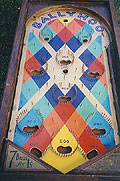By Will Hoover
Advertiser Staff Writer
Sometime around 1930, the first pinball machine arrived in Hawai‘i. It must have been a sensation. Within five years, authorities estimated there were 600 such machines in Honolulu alone.
 |
| One of the earliest pinball machines made by Bally Manufacturing, “Ballyhoo,” sold for $19 apiece in 1932, or $17 in lots of 10. Players were given seven balls for 1 cent. |
At the same time, police were fielding a crescendo of complaints from angry parents about schoolboys squandering lunch nickels on pinball. By January 1936, authorities had rounded up a half-dozen Honolulu merchants who featured pinball in their shops and charged them with violating obscure lottery laws. Pinball had officially been put on notice.
The game only got more popular.
Journalist and author David Lippman described Hotel Street before World War II
as a setting swarming "with shooting galleries, pinball machines and taxi-dance halls." By 1945, the courts had decreed it was illegal for minors in the Territory to so much as lay eyes on a pinball machine unless accompanied by an adult.
In 1957, free pinball games were outlawed. In 1960, nine Honolulu bowling alleys were raided, 15 pinball games confiscated and 16 managers arrested. More raids and arrests followed. Meanwhile, committees were formed to study "the pinball problem."
Part of the problem was confusion over the difference between flipper-less bingo-type pin games that were actually gambling devices, and flipper-type pinball machines that were intended for amusement only. Since the games looked similar, the general public usually couldn’t tell the difference.
It wasn’t until 1980 — a half century after the threat
of pinball began — that the Hawai‘i Supreme Court, in a unanimous decision, struck down laws that prohibited operators from allowing, or kids from playing, pinball.
By that time, no one much cared, because a new menace had arrived on the scene: coin-operated video games.
[back to top] |

 The Great Index to Fun
The Great Index to Fun